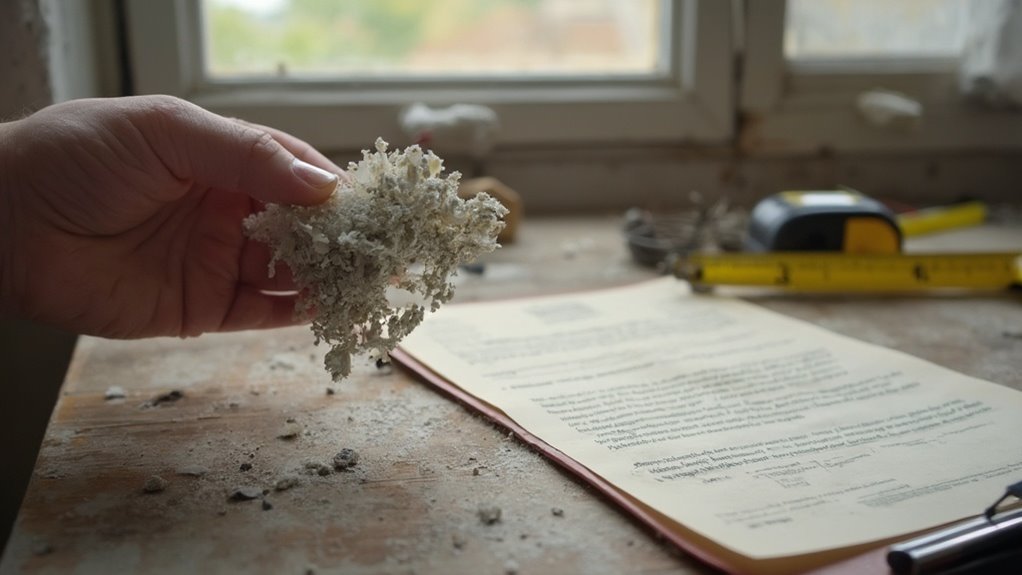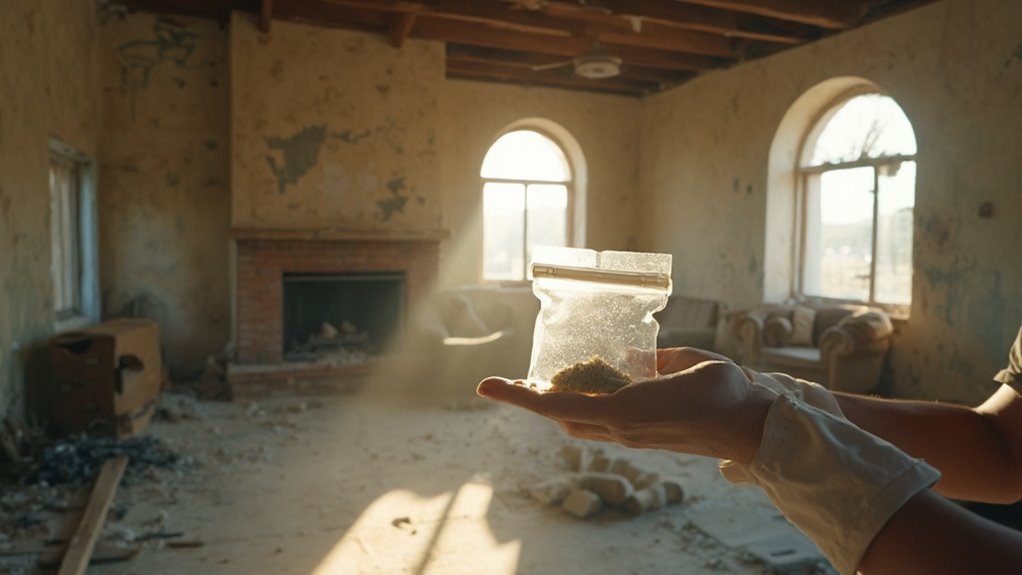As a homeowner, prioritizing asbestos testing is essential for safeguarding your health and property. Exposure to asbestos can lead to severe illnesses, including lung cancer and mesothelioma, often surfacing decades later. Testing helps identify hazardous materials before they escalate, ensuring regulatory compliance and protecting your investment's value. With properties built before 1980 at higher risk, you can't afford to overlook this. Early detection can prevent expensive remediation costs and legal liabilities. Investing in professional testing guarantees accurate results and well-informed choices. Recognizing the importance of proactive measures will better equip you to manage this hidden threat.
Health Risks of Asbestos

Asbestos exposure poses significant health risks that can manifest in various severe diseases. Inhalation of asbestos fibers can lead to serious health effects, including lung cancer, mesothelioma, asbestosis, and other chronic respiratory conditions. When you breathe in these tiny fibers, they can become lodged in your lungs, causing irritation and inflammation over time. This accumulation not only leads to scarring of lung tissue but also increases the likelihood of developing cancer, particularly mesothelioma, a rare but aggressive cancer linked directly to asbestos. Additionally, asbestos-related diseases may manifest 20 to 50 years post-exposure, making early detection and prevention crucial.
The symptoms of asbestos-related diseases often don't appear until decades after exposure, with early indicators like coughing, shortness of breath, and fatigue. Furthermore, it's essential to recognize that no level of asbestos exposure is deemed safe. Regular monitoring and air tests are recommended for known asbestos areas, ensuring a safer living environment. Populations at higher risk include asbestos workers, their family members, and residents near asbestos mines. Even smokers face an increased risk for lung cancer when combined with asbestos exposure. Understanding these health risks is critical, as it emphasizes the importance of proactive measures, such as conducting asbestos testing in your home, to safeguard your health and that of your loved ones.
Importance of Early Testing
Early testing for asbestos is essential for protecting your health and ensuring compliance with regulations. By identifying potential hazards before they escalate, you not only safeguard your well-being but likewise adhere to legal requirements that could save you from significant fines. Proactively addressing asbestos issues early on allows you to make knowledgeable choices about your property and its safety. Furthermore, understanding the health risks associated with asbestos exposure is crucial for making informed decisions regarding renovations and property sales.
Preventing Health Risks
Identifying asbestos in your home is crucial for safeguarding your health and preventing serious diseases linked to exposure. Asbestos detection isn't just about checking for fibers; it's about protecting your future. Even minimal exposure can lead to severe health risks, including asbestosis, lung cancer, and mesothelioma. Early testing allows you to address these dangers before they escalate.
Here's a quick overview of the critical implications of delayed detection:
| Health Risk | Consequence |
|---|---|
| Asbestosis | Scarring of lung tissue |
| Lung Cancer | Increased mortality risk |
| Mesothelioma | Aggressive and often terminal illness |
| Increased Cancer Risks | Linked to other cancers like colorectal |
Complying With Regulations
Maneuvering the intricate terrain of asbestos regulations is vital for homeowners planning renovations or demolitions. Understanding asbestos legislation can help you avoid costly civil fines or even criminal penalties that arise from non-compliance. State and local regulations often require asbestos testing before any significant work, particularly in non-residential buildings and multi-family units.
Early testing allows you to identify asbestos-containing materials (ACMs) and plan your project accordingly, ensuring safety for everyone involved. The Environmental Protection Agency (EPA) recommends testing damaged materials, but remember, they don't enforce a federal requirement for home testing. Local regulators may require sellers to disclose asbestos-contaminated areas, emphasizing the significance of compliance with regulatory updates in your area.
Hiring certified asbestos testers is fundamental for accurate results and minimizing exposure risks. Their thorough reports will guide you in safely removing or containing any asbestos found, aligning your project with local guidelines. By prioritizing early asbestos testing, you not only safeguard your health but likewise maintain compliance with regulations, avoiding potential legal ramifications down the road. Keep informed and proactive—don't underestimate the value of understanding and adhering to these vital regulations.
Legal Compliance Requirements

Guaranteeing legal compliance in asbestos management is crucial for homeowners aiming to protect both their properties and public health. Understanding asbestos regulations is important, as they impose specific responsibilities on you as a homeowner. Here are key legal compliance requirements you should be aware of:
- Mandatory Surveys: You must conduct an asbestos survey before any demolition or renovation, regardless of your building's age.
- Certified Professionals: Only Certified Asbestos Consultants (CAC) or Certified Site Surveillance Technicians (CSST) can perform these surveys and risk assessments.
- Access to Reports: All contractors working on your property must have access to the asbestos survey reports to guarantee no asbestos-containing materials (ACM) are disturbed.
- On-Site Documentation: Keep a copy of the asbestos survey on-site during any renovation or demolition activities.
Failure to comply with these regulations can lead to severe penalties, including fines and potential legal actions. As a homeowner, you're responsible for guaranteeing these requirements are met, safeguarding not only your property but likewise the health of your community. Ignorance isn't a defense when it comes to asbestos regulations, so stay informed and proactive.
Financial Advantages of Testing
Testing for asbestos offers significant financial advantages that can save you money in the long run. By identifying and addressing asbestos early, you can avoid costly future expenses related to health issues and property devaluation. Furthermore, ensuring your home is free of asbestos can improve its value, making it a smart investment for any homeowner.
Cost Savings Over Time
Identifying asbestos early in your home can lead to significant long-term cost savings. By utilizing effective testing methods, you can not only protect your health but likewise your finances. Here are some key financial advantages of early asbestos detection:
- Reducing Remediation Costs: Early identification of asbestos types prevents extensive contamination, which can lead to costly remediation efforts. Addressing issues proactively saves on future removal and abatement expenses.
- Preventing Unexpected Expenses: Professional testing minimizes legal repercussions and health risks associated with exposure. By identifying hazards before they escalate, you avoid costly medical treatments and potential lawsuits.
- Reducing Maintenance and Repair Costs: Asbestos testing reveals materials that could deteriorate, preventing structural damage and future repair costs. Early removal also guarantees safer renovations.
- Financial Benefits of Early Detection: While testing costs range from $90 to $2,000, early detection is typically less expensive than later remediation. Bundling testing with home inspections can further improve savings.
Increased Property Value
When it comes to boosting your property's value, addressing asbestos issues upfront can make a significant difference. Homes with identified asbestos often sell for 5-15% less than comparable asbestos-free properties, impacting your property appraisal negatively. Buyers see asbestos as a health risk, leading them to make lower offers or demand price reductions. By conducting professional testing, you not only guarantee accurate identification of asbestos-containing materials but additionally demonstrate transparency to potential buyers.
This proactive approach improves buyer confidence, reassuring them that due diligence has been performed. Properties with clear testing and mitigation plans become more attractive, aligning with current market demand. In this competitive environment, addressing asbestos can give you an edge, leading to smoother transactions and potentially higher sale prices.
Moreover, proper asbestos testing and disclosure help you meet legal requirements, avoiding any future legal headaches or fines. By taking these steps, you'll not only increase your property's market value but also create a safer environment for future occupants, further boosting your appeal to buyers. In the long run, the financial advantages of addressing asbestos are clear.
Avoiding Future Expenses
Addressing asbestos concerns proactively not only improves safety but also shields homeowners from unexpected expenses down the line. By prioritizing asbestos testing, you can leverage several financial advantages that contribute to long-term savings:
- Preemptive Identification: Early detection of asbestos saves on future remediation costs, preventing extensive financial burdens.
- Proactive Remediation: Tackling asbestos issues upfront avoids additional expenses during renovations or sales, keeping your budget intact.
- Reduced Liability: Proof of compliance minimizes legal risks and potential lawsuits, safeguarding your financial interests.
- Lower Insurance Premiums: Resolving asbestos concerns can lead to reduced insurance costs, adding to your savings.
Common Misconceptions Explained

Misconceptions about asbestos often cloud homeowners' understanding of its risks and management. One prevalent myth is that asbestos is only found in very old buildings. In reality, homes built or renovated as late as 2000 can still contain asbestos materials, especially since leftover products circulated from previous decades. Moreover, many believe that asbestos is safe if left undisturbed; nevertheless, deteriorating materials can release harmful fibers without any direct disturbance.
Another common misconception is that asbestos is easy to spot. Asbestos fibers are microscopic, making professional testing fundamental to accurately identify their presence. Some homeowners may think that testing is unnecessary and costly, but the truth is that the cost of testing is negligible compared to the potential health risks associated with exposure. Regular assessments are critical for ensuring safety, as home activities can stir up asbestos fibers, increasing exposure risk.
Understanding these asbestos myths is imperative for your safety and well-being. By prioritizing professional testing, you can make educated choices about your home and protect your family from the serious health risks associated with asbestos exposure.
Proactive Measures for Homeowners
Taking proactive measures is essential for homeowners when it comes to managing the risks associated with asbestos. Many people fall for asbestos myths, believing that it's only a concern in older homes or that visible damage is necessary for testing. In reality, even minor wear can release harmful fibers. Here are four key steps you should take:
- Ventilation Control: Turn off HVAC systems and fans to prevent fiber dispersal during testing.
- Area Isolation: Seal off the testing area with plastic sheeting to avoid exposure.
- Material Identification: Identify potential asbestos-containing materials (ACMs) in locations like insulation and flooring, especially if they're damaged.
- Professional Involvement: Engage a qualified asbestos professional who follows strict safety protocols and uses reliable testing techniques.
Safe Renovation Practices

Renovating your home can greatly improve its value and livability, but it likewise brings risks, especially if asbestos is present. To guarantee a safe renovation, adhere to the following renovation guidelines that prioritize safe practices.
| Safe Renovation Practices | Description |
|---|---|
| Asbestos Testing | Test for asbestos to identify any ACMs before starting renovations. |
| Limit Access | Restrict access to areas with damaged asbestos materials to minimize exposure. |
| Hire Professionals | Engage trained and accredited asbestos professionals for removal and major repairs. |
Before you start any work, remember that disturbing asbestos-containing materials can release harmful fibers into the air. These fibers pose significant health risks, including cancer and asbestosis. Always wet asbestos materials before removal to minimize airborne fibers, and use appropriate cleanup methods, such as wet mops or HEPA vacuum cleaners.
Lastly, verify compliance with local regulations regarding asbestos handling. Written contracts detailing work plans and safety measures are crucial to protect both you and the contractors involved. By following these safe practices, you can safeguard your health and improve your home's value without unnecessary risks.
Professional Testing vs. DIY
When it comes to asbestos testing, homeowners face a crucial choice between professional testing and DIY kits. While DIY testing might seem tempting because of lower costs, the risks often outweigh the benefits. Here's why you should consider professional expertise over DIY testing:
- Accurate Results: Professionals use high-quality equipment and follow strict safety protocols, guaranteeing precise identification of asbestos-containing materials (ACMs).
- Safety Risks: DIY kits can disturb asbestos fibers, increasing exposure risks without proper safety gear and protocols.
- Comprehensive Coverage: Professionals know where to look for hidden ACMs, while DIY testing may miss essential areas, leading to false reassurances.
- Legal Compliance: Accredited professionals provide legally recognized reports, which can be crucial for real estate transactions and construction permits.
Choosing professional testing not only maximizes your safety but also guarantees reliable results. The expertise of trained professionals, combined with accurate sampling techniques, minimizes health risks and provides peace of mind. In the long run, investing in professional testing is a smart decision that helps protect your home and health.
Long-term Health Considerations

Understanding the long-term health considerations associated with asbestos exposure is essential for homeowners, especially after weighing the benefits of professional testing. Long-term exposure to asbestos can lead to severe chronic conditions, including asbestosis, mesothelioma, and lung cancer. These diseases often develop silently, taking 15 to 50 years to manifest after initial exposure, making early detection critical.
Asbestosis causes scar-like tissue in the lungs, impairing both lung and heart function. Mesothelioma, a rare cancer affecting the lining of internal organs, is particularly aggressive, with a dire prognosis. Even minimal exposure can increase your risk of developing these conditions, especially when combined with other risk factors like smoking.
You may not realize that asbestos fibers can cling to clothing, putting family members at risk. Furthermore, symptoms such as persistent cough, chest pain, and fatigue can indicate serious health issues linked to asbestos exposure. By prioritizing testing, you can mitigate these risks and address potential hazards before they escalate into life-threatening conditions. Don't wait for symptoms to arise; proactive measures today can safeguard your health for years to come.
Frequently Asked Questions
How Long Does Asbestos Testing Typically Take?
Asbestos testing duration varies; it's quick yet detailed. The testing process overview includes sample collection on-site, followed by laboratory analysis, with results typically ready within 24 hours to a week, depending on circumstances.
What Should I Do if Asbestos Is Found?
If you find asbestos, don't disturb it. Follow safety precautions by sealing off the area, keeping people away, and hiring trained professionals for asbestos removal. Regularly inspect for damage to guarantee ongoing safety.
How Often Should I Test for Asbestos?
You should assess testing frequency based on building age, previous findings, and risk levels. By maintaining asbestos awareness, you can determine when regular inspections are necessary, ensuring a safer environment for you and others.
Can I Sell My Home With Asbestos Present?
Yes, you can sell your home with asbestos present, but you must follow asbestos regulations. Be aware that homebuyer concerns about health risks may impact your sale price and require transparent disclosure during the selling process.
What Qualifications Should I Look for in a Testing Professional?
Over 70% of homes built before 1980 contain asbestos. When selecting a professional, verify they have certification credentials and experience with various testing methods to assure accurate results and safe handling of hazardous materials.
